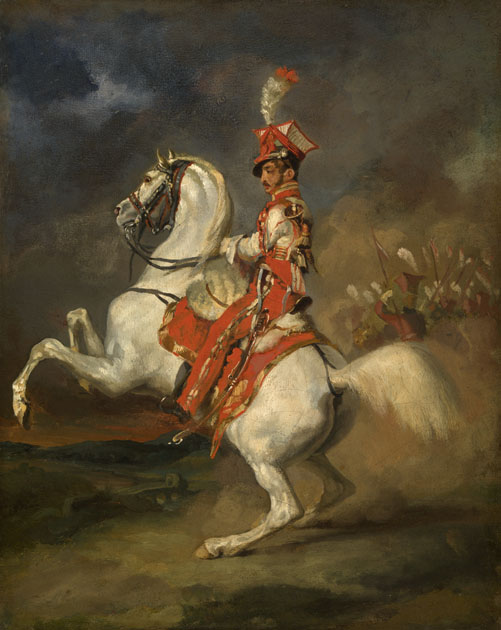Details
- Object type
painting
- Title
The Trumpeter of the Lancers of the Guard
- Artist/Maker
- Culture/School
French
- Place Associated
France, Paris
- Date
circa 1812-1815
- Materials
oil on canvas
- Dimensions
framed: 645 mm x 565 mm x 70 mm 9150 g; unframed: 406 mm x 326 mm; rebate: 425 mm x 345 mm
- Description
-
This small oil is one of a number of paintings of thoroughbred horses bearing resplendent soldiers that Géricault produced in the period 1812-1815. Both horse and rider have been brought to such a high degree of finish that we assume that they are portraits studied from the life. But they are not.
Géricault has invented the composition combining his knowledge of the equestrian paintings by Rubens and Van Dyck that he would have seen in the Louvre with impressions gathered at the stables of Versailles. He revels in detailing the rich colour of the trumpeter’s elegant uniform - the white jacket trimmed with braid, the wide gold stripe on the trousers, the distinctive plume, the notes of light highlighting the trumpet slung from his back and the curve of the sabre, echoed in the horse’s neck and hind quarters, and in the trumpeter’s back.
Géricault would have worked this painting up from a number of drawings and sketches – some done from life, others from memory or imagination. He
may also have made use of a wax maquette of a rider on a rearing horse – he is known to have had such a statue in his studio.
Where in The Prancing Grey Horse Géricault has used free and expressive brushstrokes to suggest the fiery passion of a startled animal, here he uses finely blended brushstrokes to capture and highlight the details of the trumpeter’s uniform. The subtle and refined execution means that we experience few of the tensions that we normally find in Géricault’s work – and this is surprising. Tension is what we would expect to find in military pictures painted in a time of national crisis.
In choosing to paint such a subject Géricault was undoubtedly inspired both by his passionate love of horses and by Napoleon’s military campaigns. But what did Géricault intend to do with these small paintings? As the Géricault scholar Lorenz Eitner has written: ‘There is an aura of mystery around these delicate yet intense images of military life. They resist classification. Neither true portraits nor genre scenes, they are too carefully finished to be taken for simple studies.’
He continues: ‘Géricault does not seem to have regarded them as self-sufficient, exhibitable pictures, or to have planned to work them up into full-scale Salon entries…It is the brilliance of the uniforms rather than any action or event that gives to these curiously still-life like pictures a kind of visual poetry. They contain no suggestion of symbolic significance, no hint of fatality or doom. The soldiers impassively exhibit themselves as models of martial splendour…’
- Credit Line/Donor
Gifted by Sir William and Lady Burrell to the City of Glasgow, 1944
- Collection
Burrell Collection: Pictures [Oils, Pastels and Watercolours]
- ID Number
35.270
- Location
Burrell Collection
